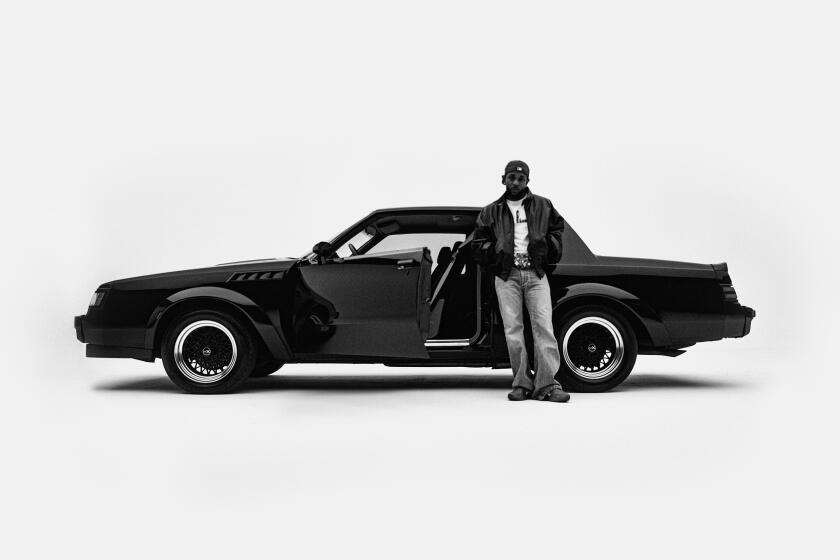Elvis Presley’s ‘Elvis 75: Good Rockin’ Tonight’ set showcases King’s artistry
- Share via
Elvis Presley “Elvis 75: Good Rockin’ Tonight” RCA/Legacy
The easiest way to have put together the new Elvis Presley CD anniversary package would have been to simply fill the four discs with the rock icon’s 104 Top 40 singles.
But RCA/Legacy has given us something far more valuable in the boxed set, which is designed to commemorate what would have been Presley’s 75th birthday on Jan. 8.
“Elvis 75: Good Rockin’ Tonight” ignores half of the hits to make room for selections that document the best of Presley, including the pre-”Heartbreak Hotel” tracks that largely defined rock ‘n’ roll in the 1950s.
The result is the most comprehensive look ever at Presley’s artistry, as opposed to just his fame.
In outlining their goals for “Elvis 75,” producer Ernst Jorgensen and art director Roger Semon declare in the set’s preface that while the chart hits are of crucial importance, only “when heard in the context of some of the lesser-known artistic achievements can they present a complete picture of an artist with a repertoire so vast that he released 711 master recordings during his lifetime.”
The set, which is due out Tuesday, lives up to those goals, showcasing the depth and range of Presley’s musical vision -- his feel for rock’s country, blues and gospel roots and his prowess with high-energy rock and revealing ballads.
Here are the 13 tracks from the boxed set that best illustrate Presley’s artistic progression.
“That’s All Right”
(Recorded in 1954 in Memphis) This is the moment when Presley, working with Sun Records producer Sam Phillips, defined rock ‘n’ roll: both its sound and youthful attitude. Checking in at just under two minutes, it is as revolutionary a slice of music as Bob Dylan’s “The Times They Are A-Changin’.”
“Baby, Let’s Play House”
(1955, Memphis) Presley ups the ante here, revising the words of a minor R&B hit by Arthur Gunter and increasing greatly the passion to better express the sexual pulse and youthful insistence that would be crucial, early building blocks for rock.
“Hound Dog” and
“Don’t Be Cruel”
(1956, New York). These tracks were released as the A and B sides of a single and both went to No. 1. In “Hound Dog,” Presley showed how the energy and grit of rock ‘n’ roll could connect with a mass audience. On the flip side, he demonstrated how he could be playful and charming without losing his edge.
“One Night”
(1957, Hollywood) Presley reached back to his Memphis roots for the sexual tension and energy in this reworking of a Smiley Lewis R&B hit. He changed Lewis’ lyrics from “one night of sin / is what I’m now paying for” to “one night with you / is what I’m now praying for,” but the vocal remained as steamy and urgent as country and blues could get.
“Blue Christmas”
(1957, Hollywood) Ernest Tubb had a country hit with this song in 1948, but Presley’s interpretation brought a whole new dimension to it as he used the sentimental currents of the Christmas tale to amplify the heartache in the lyrics. Key line, “You’ll be doing all right with your Christmas of white / But I’ll have a blue Christmas.”
“How Great Thou Art”
(1966, Nashville) Gospel was Presley’s first love and this might be his most captivating vocal ever -- a declaration of faith that is chilling.
“If I Can Dream”
(1968, Hollywood) A rare step into social commentary that was a sign of daring and maturity.
“Suspicious Minds”
(1969, Memphis) Presley seems to be trying to exorcise the memory of all those heartless movie tunes in a single, explosive moment.
“Stranger in
My Own Home Town”
(1969, Memphis) Recorded just a month after “Suspicious Minds,” this track finds Presley still celebrating his musical rebirth as he turns this bluesy Percy Mayfield tune into a personal statement about his struggle to regain his musical and personal identity.
“An American Trilogy”
(1972, Las Vegas) In tackling Mickey Newbury’s inspired linking of three 19th century tunes, including “The Battle Hymn of the Republic” and “Dixie,” Presley again steps into new territory as he celebrates the healing of a once-divided land.
“Burning Love”
(1972, Hollywood) Almost 20 years after “That’s All Right,” Presley proved he could still convey the initial energy and innocence of rock as well as anyone who followed him.
“Always on My Mind”
(1972, Hollywood) The song was written by Wayne Carson, Johnny Christopher and Mark James, but Presley gives it such a heartfelt vocal, turning it into a personal message to his ex-wife, Priscilla.
Backtracking is a monthly feature highlighting CD reissues and other pop items of historical interest.
More to Read
The biggest entertainment stories
Get our big stories about Hollywood, film, television, music, arts, culture and more right in your inbox as soon as they publish.
You may occasionally receive promotional content from the Los Angeles Times.










